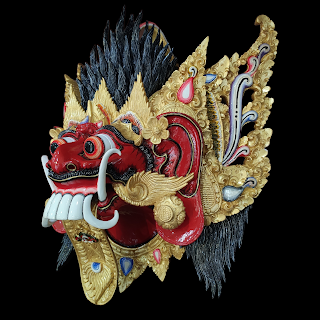Rangda The Embodiment of The Goddess Durga.
Rangda in Balinese Hindu mythology can be seen from two sides, namely the artistic side and the religious side. Both have the same meaning but different story backgrounds. The following is a review of Rangda.
In Hindu mythology, Rangda is a figure who constantly fights against Barong. Rangda is described as a woman with a scary figure, long matted hair, bulging eyes, long fangs and nails, long tongue sticking out, and long breasts.
According to the book "Keberadaan Barong dan Rangda Dalam Dinamika Religius Masyarakat Hindu Bali(The Existence of Barong and Rangda in the Religious Dynamics of Balinese Hindu Society)", when viewed from a religious perspective, Rangda is a manifestation of the incarnation of Goddess Uma to become Goddess Durga. In the Lontar Usadha Taru it is told that Lord Shiva experienced a very severe illness, so he ordered Goddess Uma to find a cure in mayapada (the world). In search of medicine for Lord Shiva, Goddess Uma asked every tree and grass that She met. The grass and trees have their own inhabitants so that they can answer Dewi Uma's questions and explain their benefits and properties starting from the roots, skin, to the leaves. Until finally at noon, Goddess Uma arrived at Setra Gandamayu at a large tree, namely Taru Rangdu. Seeing the tree, Goddess Uma began to ask about the benefits of this tree. At midday it is a forbidden time because the tree dwellers are fast asleep. Hearing the noise outside finally the Banaspati Raja woke up from his sleep and would eat anyone in front of him, so he attacked Goddess Uma and the battle could not be avoided. In order to be able to defend herself, Goddess Uma changed her form into the very scary Goddess Durga to be able to match the power of the Banaspati Raja. The Banaspati Raja lost the battle and fled. Seeing this defeat, the followers of the Banaspati Raja became angry and attacked Goddess Durga, but were easily defeated by Dewi Durga. Seeing these conditions, the Banaspati Raja changed his form into a very powerful animal with a bell on his leg (which is known as the Barong). After changing the form of the battle with Goddess Durga was continued.
As the embodiment of Goddess Durga, Rangda is sacred to many Balinese Hindu. As for Rangda's stature in the concept of worship Goddess Durga, it differs according to her figure/form, namely:
Nyinga: The form of Rangda's figure which resembles a lion with protruding parts. This face shape has a wild and vicious impression.
Nyeleme: The shape of Rangda's figure which resembles a human and is slightly widened. This face has a charismatic and terrible impression.
Giant: Rangda's figure that resembles a giant's face. This face has a scary character.
In some sense, Rangda is interpreted as a widow. This is in line with Calon Arang's story. In this story, the character Rangda is the character of an evil widow who studies black magic named Calon Arang. Because of his strength, Calon Arang spread pain throughout the village because no one wanted to marry her daughter. However, as time went on, Calon Arang was able to be defeated by Mpu Bharadah and the condition of the village was able to return to normal. The story of Calon Arang develops in the lands of Java and Bali. In the Javanese tradition, the story of Calon Arang is set forth in a papyrus dated 1540 AD, while in the Balinese tradition, this story is preserved in geguritan or folk literature.
From the two meanings above, Rangda reflects a symbol of negative power and is the opposite of Barong, which reflects a symbol of positive power. Rangda and Barong are symbols of good and bad dualism or in Balinese Hindu society it is called Rwa Bhineda.
Read also : Barong the Guardian in Balinese Hindu Belief
Glossary :
B
Barong : A Hindu mythological creature with a shape that is described as resembling a lion, bulging eyes, sharp fangs, and has hair all over its body.
G
Geguritan : An oral tradition passed on by word of mouth.
L
Lontar : Ancestral heritage texts contain ancient histories that are part of the Vedic scriptures.
Lontar Ushada Taru : One of the lontar titles in Balinese Hindu beliefs.
M
Mpu : A title given to someone who can guide the People in terms of developing and fostering human and natural life in a balanced way.
R
Rangda : Negative power symbol; The leader of the leyak in Balinese Hindu mythology; The incarnation of Goddess Dhurga who served as destroyer or destroyer.
Rwa Bhineda : The concept of difference between good and bad in Balinese Hindu belief to achieve balance.
S
Setra : Cemetery.
Setra Gandamayu : a name of a grave which is the starting point for the soul's journey to the afterlife.
T
Taru : Tree.
Sources:
(1) Indonesia Kaya. (n.d). Tari Barong Rangda, Menghantar Khalayak Awam Memahami Konsep Rwa Bhineda. Diakses melalui : https://indonesiakaya.com/pustaka-indonesia/tari-barong-rangda-menghantar-khalayak-awam-memahami-rwa-bhineda/
(2) Wirawan, Komang Indra. (2021). Keberadaan Barong dan Rangda Dalam Dinamika Religius Masyarakat Hindu Bali. PT Japa Widya Duta. Denpasar
(3) Maharani, Ni Putu Sinta. (2021). Rangda, Makhluk Spiritual Penguasa Kuburan di Bali. Binus University. Diakses melalui : https://student-activity.binus.ac.id/kmh/2021/11/30/rangda-makhluk-spiritual-penguasa-kuburan-di-bali/
(4) Ariefana, Pebryansah. 2021. Cerita Rakyat Bali Calon Arang, Kisah Janda Tua Sakti Jadi Leak. Diakses melalui : https://bali.suara.com/read/2021/10/19/080500/cerita-rakyat-bali-calon-arang-kisah-janda-tua-sakti-jadi-leak
Author : Ni Kadek Dian Utami Kartini
Editor : I Gusti Putu Adi Febra Nugraha
#balinese #balinesemythology #barong #rangda #balinesewoodcarving #barongdance #rangdawitch #dhurga #calonarang



Comments
Post a Comment